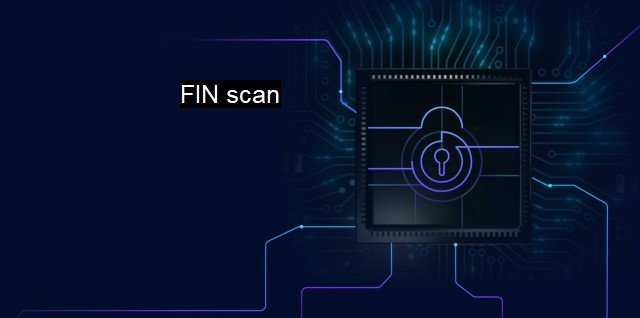What is FIN scan?
Understanding the Technical Aspects of FIN Scan: Mitigating Vulnerabilities and Threats to Cybersecurity and Privacy
FIN scan is a method used in the cybersecurity environment by hackers or security experts to explore network-handling processes. This method is utilized to identify open ports and accordingly categorize the host's operating system, enabling attackers to identify potential vulnerabilities that can be exploited within the system. Fin Scan is a particular network scanning technique part of the host or network enumeration phase in which the most important information about the victim's network is collected.A FIN scan operates by sending TCP (Transmission Control Protocol) segments containing active FIN control bits to a targeted port. In the context of TCP, a packet containing a FIN bit signals the conclusion of data transmission by the sending user. This process is also referred to as 'connection termination.' While widely recognized in the cybersecurity industry for its potential misuse, this type of scanning can also prove useful in network diagnostics or troubleshooting.
The Standard TCP/IP network models include a clause that, once an unsolicited FIN (or Finish) packet is received by a closed port, it will respond with an RST (or Reset) packet. an open port will ignore this unsolicited FIN packet, leading to no response. This characteristic loophole helps the hacker identify the status of a particular port regarding whether it's open or closed based on its acknowledgment or ignoring the FIN packet.
FIN scanning, also popularly known as Stealth-FIN scanning, is considered 'stealthy' because it veils its detection from the targeted user or system. Normally, network hosts log the standard SYN scanning but forgoing the whole three-way handshake involved in a typical TCP connection, which is SYN-SYN/ACK, ACK, makes the FIN scanning type more discrete and harder to log or detect.
Typically, FIN Scans are traced manually. This tactic often requires an auditor who will undertake precise tracking for incoming and outgoing packets. Likewise, most organizations use Intrusion Detection Systems (IDS) to track suspicious network traffic actively and alert inspectors about possible attacks. it is crucial to maintain IDS consistently updated because of priors using FIN Scans for distorting a mole's actual size or impending attack.
Hackers apply FIN scanning as a data collecting tool for seeking open channels to exploit and compromise their victim's system. 'ethical hackers,' also known as penetration testers, also utilize FIN scanning to identify potential weaknesses in the network. This discovered information helps bolster cybersecurity, reimagine weak spots, and preemptively resolve any impending threats.
The drawback of FIN scanning is in its unreliability in correctly identifying port statuses against particular Windows operating systems; regardless, it serves as a challenging stealth technique against IDS and firewalls. or most operating system's detection software lack sufficient algorithms to detect FIN Scans, which, on the one hand, makes FIN Scanning a formidable cybersecurity threat, but also advocates for significant enhancements and progressive advancements in the network defense apparatus.
Malware and antivirus scanners adjusted to recognize and discontinue unusual traffic patterns can deter FIN scanning. specialized attacks could potentially overrun such programs, making it a constant arms race between attackers and defenders.
FIN scanning exists in the realm of complex cybersecurity threats. Preventive measures include regularly updating firewalls, intrusion detection systems, and engaging in constant vigilance of network traffic. It's also recommended to frequently undertake penetration testing to discover and address any existing weaknesses in the network.
In a world increasingly interconnected with rapid information flow, understanding the threats and vulnerabilities of the cyber environment only becomes critically essential. With effective measures taken, the risk element linked with FIN scan can be greatly regulated, promoting the creation of a broader, secure cybersecurity network.

FIN scan FAQs
What is a fin scan in cybersecurity?
A fin scan is a type of port scan that is used to identify open ports on a target system. It is a stealthy scan because it does not complete the three-way handshake required by TCP. Instead, it sends packets with the FIN flag set to the target port, and if the port is open, it will send back a RST packet.Is a fin scan a type of virus?
No, a fin scan is not a virus. It is a technique used by cybersecurity professionals to detect vulnerabilities in a system.Can antivirus software detect a fin scan?
Antivirus software is not specifically designed to detect a fin scan, but it may flag it as suspicious behavior. However, antivirus software can detect the vulnerabilities and exploits that fin scans are trying to identify.How can I protect my system from a fin scan?
The best way to protect your system from a fin scan is to keep your system up-to-date and patched with the latest security updates. It is also recommended to use a firewall and intrusion detection software to alert you to any suspicious activity on your system.| | A | | | B | | | C | | | D | | | E | | | F | | | G | | | H | | | I | | | J | | | K | | | L | | | M | |
| | N | | | O | | | P | | | Q | | | R | | | S | | | T | | | U | | | V | | | W | | | X | | | Y | | | Z | |
| | 1 | | | 2 | | | 3 | | | 4 | | | 7 | | | 8 | | |||||||